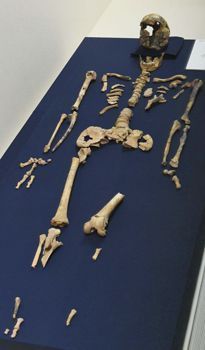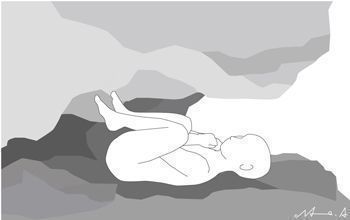Shiraho Saonetabaru Cave Ruins confirmed as first graveyard during Old Stone Age in the country

Shiraho No. 4 human skeleton with almost full body skeleton remaining, at the Okinawa Prefectural Buried Cultural Property Center, Nishihara, on the afternoon of May 19.
May 20, 2017 Ryukyu Shimpo
On May 19, at the Okinawa Prefectural Buried Cultural Property Center, Nishihara Town, the prefectural education board announced the results of the investigation into the Shiraho Saonetabaru Cave Ruins, which was conducted between fiscal 2012 and 2016.
The cave ruins were confirmed as the first graveyard in the old Paleolithic age in Japan.
At least 19 pieces of full-body human skeletons from the Old Stone Age were found, which is the largest deposit of its kind in the world.
Kamenobu Kinjo, director of the center, emphasized, “It is an important discovery worth a lot to Japanese anthropology and archeology research.”
Among the 19 bodies that were excavated, the human bone tagged No. 4 is from about 27,000 years ago (using calibration age), five thousand years older than the Minatogawa Human Bone.
There were almost full-body skeletons including skulls, and their posture when they were buried became distinguishable.
According to the prefectural education board, it was a funeral similar in style to burial by exposure to the elements, in which remains were placed in a narrow rock-shade on the ground, not in under the ground.”
Regarding the cave ruins previously being judged as a graveyard, the prefectural education board cited the fact that multiple human bones were found in five caves.

Diagram of burial posture was revealed from “No. 4 Human Bone” (provided by the Prefectural Board of Education)
Chiaki Katagiri, chief expert at the center, said, “There is a high possibility that the place to mourn for the dead and the place for the living were separated, outside and inside the cave respectively.”
However, the prefectural education board officials said it is still to be determined how the ruins will be utilized in the future.
Ishigaki Mayor Yoshitaka Nakayama said, “It is a valuable asset for the island. I think there is a possibility it could be a tourist attraction.”
Ayano Shimabukuro, assistant manager of the municipal board of education and cultural properties section, said, “We want citizens to be able to get close to the valuable ruins.” However, she indicated that there is a problem concerning safety because the ruins are located within the airport.
Glossary: Paleolithic age and calibration age
The Neolithic era, during the period when stones were used as the main tools, about 16,000 years ago, is equivalent to the Jomon period in Japan and the Kaizuka period in Okinawa.
The dating of the Paleolithic Age has been carried out using the radioactive carbon method, but in recent years, the calibration age verified by the annual rings of plants has also been used to determine the date.
The calibration age is about 4,000 years older than the radioactive carbon age, and is closer to the real age.
(English translation by T&CT)
Go to Japanese
Previous Article:Itoman City and Okinawa Prefectural Government taking measures to prevent illegal waste dumping in Mabuni
Next Article:Fearless bullfights entertain 4000 onlookers
[Similar Articles]
- 24000 year-old human remains discovered at Shiraho Saonetabaru Cave Ruins in Ishigaki City
- Discovery of oldest East Asian full-body human skeleton at Shiraho Saonetabaru Cave Ruins
- 9,000-10,000-year-old bone fragments discovered in Okinawa thought to be missing link between Paleolithic and Kaizuka-era humans
- Human bones dating back 9,000 years found at Sakitari Cave
- Japan’s oldest shell tools found in Sakitari Cave in Okinawa
 Webcam(Kokusai Street)
Webcam(Kokusai Street)


